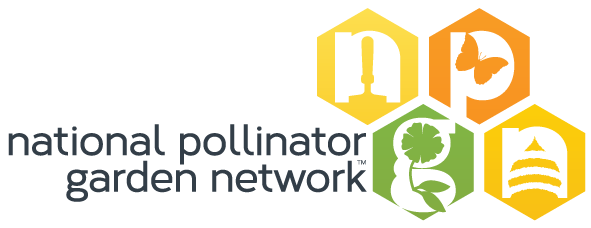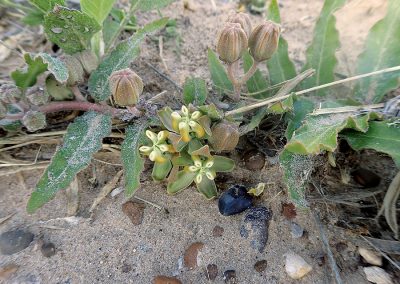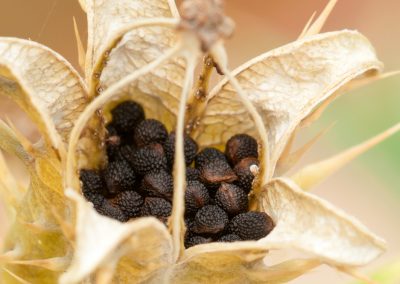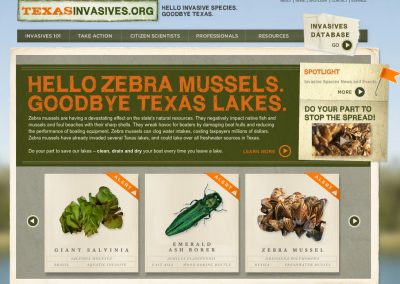Pollinator Conservation
Native pollinators—bees, butterflies, moths, bats and birds—play a critical role in sustaining ecosystems and provide essential services to American agriculture (estimated at as much as $9 billion annually).
Yet pollinators are in trouble. More than 50 native bees are in documented decline, with nine critically imperiled, including the Franklin’s bumble bee. Another iconic North American pollinator—the monarch butterfly—is in severe decline, down from a billion monarchs 20 years ago to 35 million today. Research shows that native pollinators can be two to three times as effective at pollinating agricultural crops as non-native honeybees.
Native pollinators need native plants and natural landscapes to survive. The Wildflower Center helps by:
- Creating pollinator habitats in urban planned landscapes such as at the George W. Bush Presidential Center in Dallas and the Mission Reach on the San Antonio River
- Helping gardeners find thousands of plants that sustain bees and butterflies
- Educating school groups, parents and children about native pollinators and the plants that they need
- Supporting pollinators on our 279 acres in Austin
- Providing sustainably grown native plants at plant sales for homeowners to create pollinator-friendly gardens
- Conserving seeds of important pollinator plants for future use and research
DIG DEEPER
Support Monarchs Through Project Milkweed
Become a Milkweed Grower
Join the Million Pollinator Garden Challenge
How Pollinators Help Cotton Farmers
Browse Pollinator-Friendly Plants by Region or Insect
LOCATION
Based at the Wildflower Center
PROJECT DATES
- Ongoing
PARTNERS
- Monarch Joint Venture
- Monarch Gateway
- Journey North
- National Pollinator Garden Network
- The Xerces Society
- Butterflies and Moths of North America
CONTACT
PROJECT FEATURES
Resources
Pollinator-Friendly Plants for Texas
Pollinator Plants by Region
- California Pollinator Plant List (California)
- Great Lakes Pollinator Plant List (Ontario, Northern Minnesota, Wisconsin, Ohio, Michigan, Pennsylvania and New York)
- Mid-Atlantic Pollinator Plant List (Southern New York, New Jersey, Pennsylvania, Delaware, Maryland, Virginia, West Virginia, and Northern North Carolina)
- Midwest Pollinator Plant List (Iowa, Missouri, Illinois, and Indiana)
- Northeast Pollinator Plant List (Quebec, Newfoundland, Nova Scotia, Prince Edward Island, Maine, New Hampshire, Vermont, Massachusetts, Connecticut, Rhode Island, and eastern New York)
- Maritime Northwest Pollinator Plant List (Oregon, Washington, and British Columbia
- Butterfly and Moth Plants for North America
Plants of Special Value to Beneficial Insects
- Special Value to Native Bees – Attracts large numbers of native bees.
- Special Value to Bumble Bees – Attracts large numbers of bumble bees.
- Special Value to Honey Bees – Important pollen or nectar sources for honey bees.
- Provides Nesting Materials/Structure for Native Bees – Plants that native bees nest beneath, within, or harvest parts from to construct their nests.
- Supports Conservation Biological Control – Plants that attracts predatory or parasitoid insects that prey upon pest insects.
- Milkweed Finder – Find Sources of Native Milkweed Seed in Your State.
- Milkweeds: A Conservation Practitioner’s Guide – Plant Ecology, Seed Production Methods, and Habitat Restoration Opportunities.
Other Resources
- Presidential Memorandum – Creating a Federal Strategy to Promote the Health of Honey Bees and Other Pollinators (June 20, 2014).
- Supporting the Health of Honey Bees and Other Pollinators – Guidance for Federal Agencies on Sustainable Practices for Designed Landscapes and Supporting Pollinators on Federal Landscapes (October, 2014).




